3 ECS Key Application Areas

3.6
Digital Society
Supporting the digital transformation throughout society
This Chapter describes the type of digital innovations that are essential to stimulate an inclusive and healthy society, and which will in turn contribute to solutions for European challenges in the fields of health, mobility, security, energy and the climate, and consequently to European economic prosperity.
Europe needs digital solutions that support the individual, and at the collective level to empower society as a whole. These (smart) digital solutions will be driven by new technologies such as 5G, Artificial Intelligence (AI) with deep learning (DL), virtual reality (VR) and augmented reality (AR), brain–computer interfaces (BCIs) and robotics. They will shape new ways of how people use and interact with these technological solutions, with each other, and with society and the environment. Digital innovations should facilitate individual self-fulfilment, empowerment and resilience, collective “inclusion” and safety, as well as supportive infrastructure and environment.
However, such a transformation will also introduce a wide range of ethical considerations. Future digital innovations will therefore need to address societal concerns in a sustainable way, guaranteeing participation and reducing inequality. A human-centred approach is therefore a key aspect of the EU’s approach to technology development. It is part of European social and ethical values, (social) inclusiveness, and the creation of sustainable, high-quality jobs through social innovation.
3.6.2.1 External requirements
To guarantee economic and societal growth in Europe, digital inclusion requires tools and infrastructures in application domain roadmaps as described in the other Chapters. Technology permeates every aspect of society and is an important instrument of change (as can be seen in Figure F.84, where two distinct rows are shown: current status and future expansion).
People’s expectations of the future impact of technology are broadly positive, but also involve specific concerns around employment, income, safety, equality and trust. By 2035 the impact of science and technological innovation will be enormous on prosperity, individual wellbeing, sustainability, fairness and trust (see Figure F.85). This underlines the importance of investing in our digital strategy today.
In striving to guarantee European sovereignty to support European digital societal goals (for instance, through the GAIA-X140 project), safety, equality and trust are key requirements. What does this mean for electronic components and systems (ECS) for our society? Ubiquitous connectivity (“everywhere and always on”), online services and social media (“always online”) drive people to rely on intelligent applications and the services they offer. Public and private infrastructures will increasingly be connected, monitored and controlled via digital infrastructures (“always measuring”).
Two important further drivers for European society and economy – from a human-centred approach on AI perspective – are lifelong learning and training, as well as being able to work anywhere, anyplace. The trend to work from home whenever possible, which has been triggered by the Covid-19 pandemic, will continue, and people will endeavour to combine work and private life in a better way. In rural areas, as well as in cities, it should be easy to work either from home or remotely in distributed groups/workforces. This can be achieved through living labs and learning factories at both a personal and collective level.
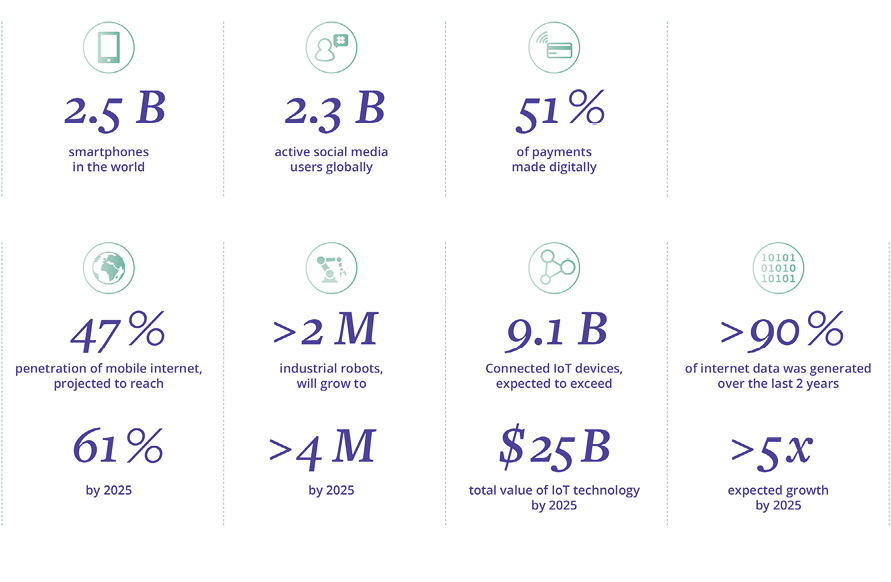
3.6.2.2 Societal benefits
All of European society will benefit from a major (AI-based) evolution in intelligent systems, on both the individual and collective levels:
- The benefit of digital inclusion for all individuals will involve employability through lifelong learning and training, and the personal wellbeing of individuals. To achieve these, the key ambition is to maximise the individual development of citizens.
- How? By ensuring personal resilience, enabling lifelong learning and development, and stimulating employability. Human-centred solutions will optimise services to each individual’s needs and level of understanding, for applications in areas such as healthcare, lifestyle, coaching, training, and working from home or remotely collaborating in a “distributed” workforce. This will boost employee productivity, improve their work/life balance and foster better mental health, and reduce pollution from commuters.
- The overall individual benefit is “wellbeing”. A factor such as “prosperity” means job security, material living standards and the right to have the optimum education, any time, any place. On an individual level, wellbeing means health for every one of every age, and also adequate housing, ensured safety, protected privacy, reliable and ubiquitous digital infrastructures, in addition to social connectedness and more intense social cohesion. Our key objective is to empower and protect the individual.


- How? By ensuring acceptable and trustable AI technologies to increase inclusion and prevent exclusion, protecting citizens against identity theft, and providing a protective environment against new virus infections; in addition, through lifestyle monitoring and coaching, to enable and support healthier lifestyles.
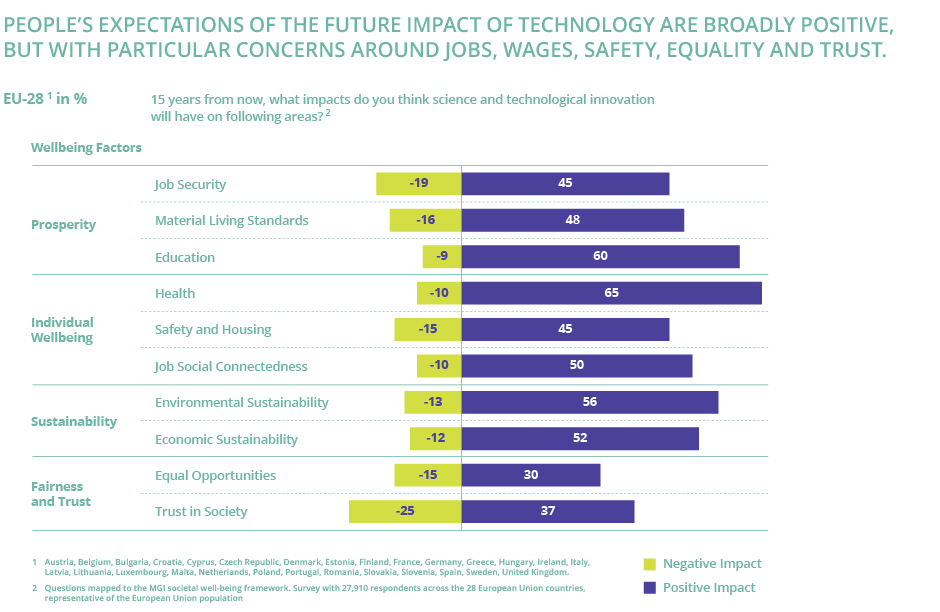
F.85 - People’s expectation of the future impact of technology (Source: Special Eurobarometer 419, Public perceptions of science, research and innovation, 2014; McKinsey Global Institute analysis) - The benefits of digital inclusion. A society resilient against setbacks, and the societal acceptance of novel technologies will achieve the key ambition of safeguarding collective society and wellbeing for all.
- How? By societal and digital inclusion, providing societal access for all, and ensuring collective resilience against setbacks. Also, the elderly will be supported to continue their social participation, which will reduce feelings of loneliness, improve their wellbeing and health, but provide reassurance that their precious experience can still be used.
- On an environmental level, the benefits are a physical and digital sustainable environment, intelligent Infrastructure management, stability and resilience against threats, and agreement on fall-back solutions in times of crises. The main aim is to contribute to a supportive infrastructure and environment.

- How? By providing reliable and resilient infrastructures, protecting society against destabilising forces, establishing a sustainable environment, and securing controlled climate change. Monitoring and intelligent control of infrastructures will also contribute to a sustainable environment by solutions that address, for example, optimal use of natural resources, reduction of pollution and crisis management. "Sustainability" means environmental as well as economic sustainability, and equal opportunities for all people. It is related to fairness and trust in our societies. It must be ensured that Al-based systems will take European-style human values into account by design. A human-centred approach will therefore be a key requirement. As such, "FAIRness" (findability, accessibility, interoperability and re-use) will help shape future applications.
Overall, a strategic advantage for the EU lies in digital solutions and people with high-developed digital skills that can contribute more efficient solutions for European challenges in the fields of health, mobility, security, energy and the climate. A digital “healthy” society will contribute to European economic prosperity. Digital tools, infrastructures, applications and digital skills will offer the following:
- Ensure companies that their labour force will work efficiently, whether they work at the head office or from their homes (i.e. to prevent virus spread, or for other reasons). An advantage here is the widespread empowerment of citizens to work from different locations, taking into account that some jobs will need to be undertaken in the office or factory, but that knowledge workers with computer-based jobs can work remotely.
- Provide people with greater employability and better protection against social or economic exclusion (the possibility of ubiquitous connectivity).
- Support citizens instead of replacing them with robots, as EU technical solutions will be based on human-centred AI systems that have a focus on human values. AI solutions applied should be trustworthy (responsible, transparent and explainable).
- Help European governments, companies and citizens to cooperate more easily, and develop reliable societal emergency infrastructures. This will make European societies better prepared to deal with emergency and crisis situations.
Widespread empowerment to work from different locations will require optimal use of (but also drive) the growth of interconnection bandwidth (see Figure F.86a). Remote working will also require further use of cloud applications (see Figure F.86b), using AI software as a service (SaaS) to automate processes and support employees in decision- making, resulting in the growth of AI (as shown in Figure F.87).

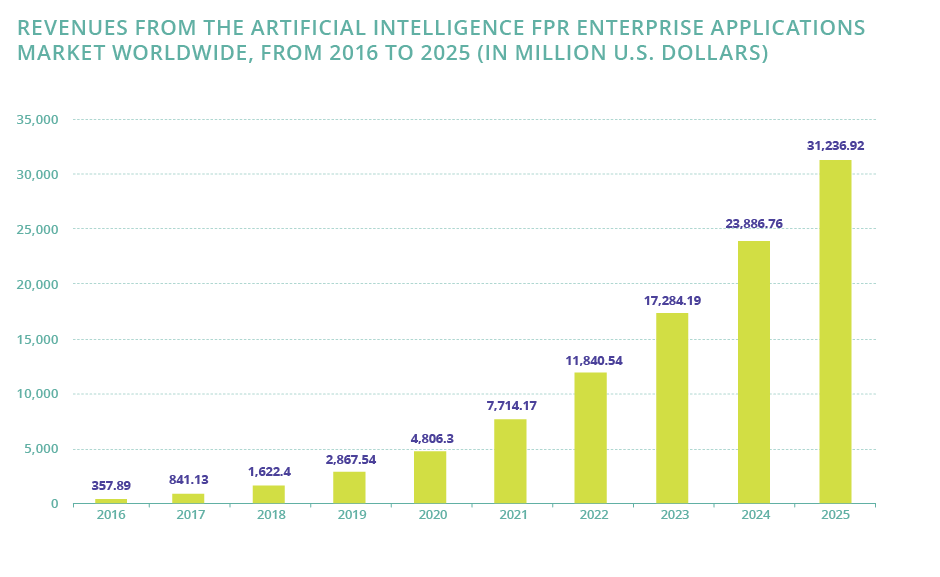
Enabling and ensuring a digital society implies various aspects will be facilitated by ECS products and services. To structure these aspects, we distinguish between the individual or collective context and the internal or external scope. This leads to the matrix shown in Figure F.88.
Each of these four areas relates to one of the following Major Challenges:
- Major Challenge 1: Facilitate individual self-fulfilment.
- Major Challenge 2: Facilitate empowerment and resilience.
- Major Challenge 3: Facilitate inclusion and collective safety.
- Major Challenge 4: Facilitate supportive infrastructures and sustainable environments.
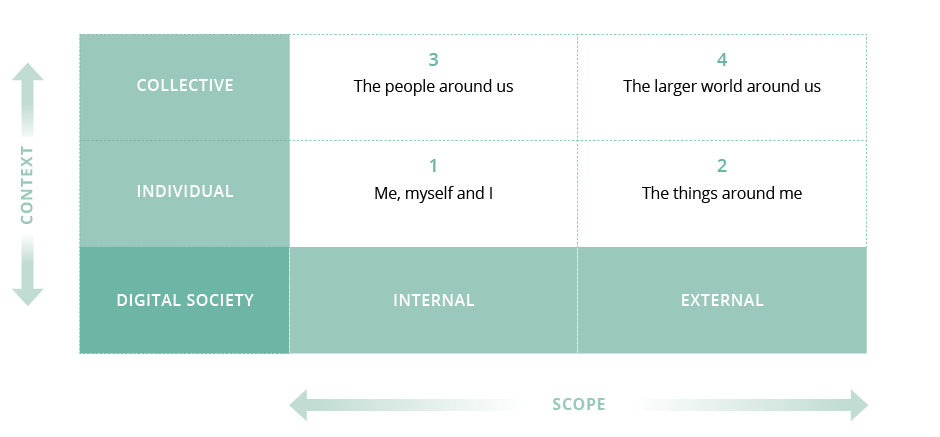
3.6.4.1 Major Challenge 1: Facilitate individual self-fulfillment
Ambition: to maximise the individual development of citizens.
- Provide empowerment to citizens.
- Ensure personal resilience.
- Enable lifelong learning for both children and adults (serious gaming, including AR/VR).
- Give citizen more freedom to do their work wherever they want/need.
- Stimulate employability.
- Wellbeing (e.g. by gamification236, connection to others, leisure).
- Improved human–machine interaction solutions for perception, reasoning and autonomy, with interaction being adaptive to the user’s abilities.
To maximise the empowerment and self-fulfilment of citizens, Europe has to strive for lifelong learning, employability and the freedom to work wherever one resides, as well as optimal wellbeing in the context of an independent and pluralistic media. These enable lifelong empowerment by keeping citizens informed and facilitate the flow of educational content. Educating through the media is an important means to develop valuable skills that will help to end violence and eradicate forms of discrimination (such as sexism and racism). More fundamentally, the media encourages the acquisition of civic knowledge and facilitates discussion concerning current issues, while at the same time entering new frontiers of engagement using on-demand and interactive paradigms, and in employing AR/ VR technologies backed by 5G/6G connectivity.
The 30-year career has become a thing of the past. Education does not end after school; individuals need to keep on learning throughout their careers to stay up to date and adapt their skills as the world changes at an unprecedented rate. To better support lifelong learning, technologies are needed that encourage collaboration, foster autonomy and responsibility, and implement learning initiatives. Technological advancements such as cloud computing, mobile devices and web 2.0 technologies are still relatively new additions to the workplace that must be further explored237.
To provide the citizen with more freedom to do their work wherever they want or need, Europe must ensure the availability of high bandwidth secure connections (wired and wireless) at all possible locations one could use to work from. This should be reinforced by easy and secure access to cloud applications, and novel AI-based solutions to automate processes, analyse data, guide the user in decision-making, and to minimise repetitive work. ![]()
Advanced technologies, including smart automation and AI, have the potential to not only raise productivity and GDP growth, but also to improve wellbeing more broadly, as well as offer a healthier life and longevity, and greater leisure time. Studies have shown that, besides income, the following factors contribute to individuals’ wellbeing and self-reported life satisfaction: social life, use of leisure, health, spouse/partner, job, flat/house and the amount of leisure238. New technologies in the digital society can, and will, influence all these factors. ![]()
An example of the relevant tools is shown in Figure F.89 for Coursera, which utilizes of gamification to offer the lifelong free and open learning of languages and brings massive open online course (MOOC) platforms to the public.
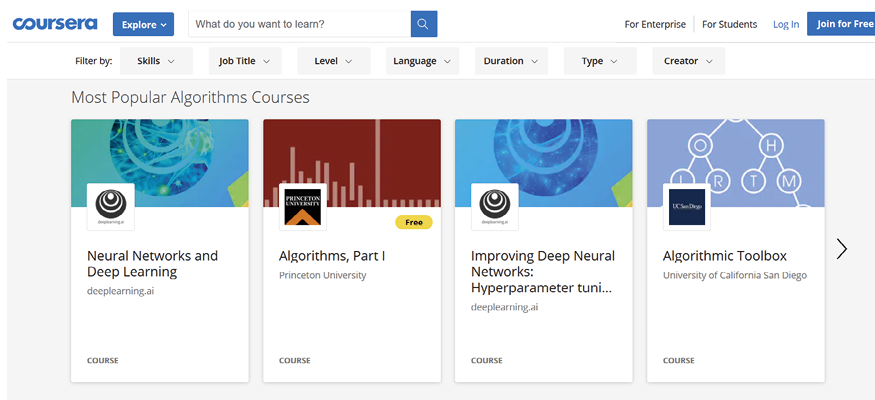
High-priority research and development and innovation (R&D&I) areas:
- Digital inclusion: tools, infrastructure, training, connectivity.
- Online education and examination: VR/AR training and support.
- Improved human–machine interaction (HCI) solutions.
- Support devices: wearables, robots, cobots, chatbots, etc.
- Nudging and serious gaming: for personal development and healthier lifestyles.
To improve the awareness of our body’s condition to external or internal stimuli, smart systems can provide support for disabilities, or a personal coach and trainer to identify behaviour to be avoided (wrong body position, bad habits), as well as possible future injuries or disorders. Smart systems can also offer an immersive experience through vision, gaming and sensory interaction by way of VR or AR. Consumers can be offered the immediacy, individualisation, interactivity and immersion they expect from media content consumption (“even better than being there”). ![]()
A healthier and more comfortable environment can be offered based on personal preferences (control of temperature, humidity, air flux, etc.), in the context of running activities and clothing, and by adapting lighting and acoustic quality to one’s own sense of wellbeing. It also provides the capability to comfortably communicate and interact remotely with people, institutions and sellers, possibly without leaving home, saving time for self- development and leisure.
Selective automation, AR at work and a range of feedback tools can help boost satisfaction and give more meaning to work. This is a particularly important element for the millennial generation, which according to surveys tends to place more emphasis on work satisfaction than on income (above a certain income level). Due to the Covid-19 pandemic, large events are becoming more difficult to organise, and many people may prefer to take part in events while not physically being present. Technological advances will make it possible to place audiences in the middle of the action and to offer them immediacy, individualisation, interaction and immersion without it being necessary for them to actually be there in person. This will further change consumption patterns and open up new business opportunities.

Required R&D&I developments within ECS
Taking the above into account, specific R&D developments are necessary within ECS technology, as shown in Figure F.90.
3.6.4.2 Major Challenge 2: Facilitate empowerment and resilience
Ambition: empower and protect the individual citizen.
- Increase inclusion and prevent exclusion.
- Protect citizens against cyber-fraud (scams) and identity thefts; provide privacy.
- Enable smart homes with ubiquitous connectivity.
- Ensure acceptable AI technologies.
Diversity and inclusion within societies are increasingly recognised as crucial for equality at work and economic development. Research has established a strong link between gender equality in society, attitudes and beliefs about the role of women, and gender equality in work239. Technology can improve equality at work – for instance, by revealing pay gaps and biases, and helping de-bias recruitment. It can also improve equal access to essential services – for example, biometrics and cloud technology can contribute to increasing the diffusion of microfinance to women and underserved populations. Technology can also help enforce inclusive legal rights, policies and social norms. While e-voting still poses a number of cybersecurity challenges, it can support diversity by facilitating the vote for vulnerable and marginalised parts of society. Finally, technology can help with physical security and autonomy for minority groups through objects and digital communications tools that reduce or mitigate exposure to risk – for example, connected devices such as smart bracelets can enable women to signal an assault and call for help.
Reliance on technology comes with many benefits, but also brings new risks240. The radical nature of the ongoing technology transition could result in risks that are not just an extension of the previous challenges, but require fundamental changes to core aspects of our society, including how we think about our identity, security and rights. Concerns about technology are justified by recent events, such as security breaches in prominent companies, data theft and information misuse. In addition, AI provides more powerful examples of potential risks. Its full potential can be utilised only if we fully rely on it for decision-making, allowing it to process data beyond the human ability to cross-check and verify. This depends a high level of trust, raising questions about and requiring new technical solutions that take into account explainability, accountability, trustworthiness and ethics.
In 2020 and 2021, we have experienced the necessity of a connected smart home and an adequate home office during the pandemic. However, the availability of high bandwidth connectivity is not yet evenly distributed geographically across Europe.
Machine learning is essential for a resilient future. AI will have a far greater chance of successful implementation if there is a focus on four key areas: augmented intelligence; intelligent automation; assessed intelligence; and adaptive intelligence. Augmented intelligence concerns augmenting and thus improving the productivity of humans. Intelligent automation is essentially about building systems that integrate humans and machines in productive ways (instead of just replacing humans entirely with machines). Assessed intelligence is all about making models robust by evaluating them rigorously and continuously. Finally, adaptive intelligence involves developing more resilient systems that can adapt to changing circumstances by shifting to a causal inference paradigm.

High-priority R&D&I areas:
- Reliable and ubiquitous digital infrastructures.
- Access control/intrusion detection/surveillance.
- Provide protective environment and tools against virus infections.
- Off-grid living and emergency survival.
In the coming years, more people will work from home as the Covid-19 pandemic forced large groups of high-skill workers to do so as of 2020. To further enable working from home, or wherever and whenever one wants, wireless and wired infrastructures will have to be further improved (through increased reliable bandwidth, lower cost, better geographical coverage and finer granularity), security of connections will have to improve to protect the worker at home (as will the company using a distributed workforce with many internet connections) against cyber-attacks, and the theft of personal and/or company information. New functionality running in the private/public cloud will be needed to support real-time actions that may suffer from latency issues over the internet, as well as to support the worker in decision-making. Examples here are control of robotic surgical devices, remote control of robots in industrial processes, remote control of cameras in security applications and live television productions, and so on. Other professions, such as translation services, voice recognition and all kind of analytical algorithms for data analysis, also come to mind. ![]()
![]()
![]()
To create equal opportunities, innovative research should include: speech-generating devices (SGD) to help people with speech disorders; exoskeletons that empower disabled people in their everyday life; semi-autonomous vehicles that increase mobility for people with deafness and blindness; smart objects linked to geospatial information to improve women’s security (e.g. invisible SOS buttons); augmentative and alternative communication tablets that help paralysed patients; VR solutions that provide realistic experiences for people with physical disabilities; and smart glasses that can be used to help people with autism on cognitive, social and emotional skills.
As of 2020, we learned that Europe will need better technologies: (i) to fight and contain the rapid spread of diseases such as Covid-19; and (ii) to ensure that public health institutions can maintain their capacity to meet the ever-increasing needs caused by such a pandemic242. The in-depth analysis provided by the European Parliamentary Research Service’s “Ten Technologies to Fight Coronavirus” identifies the importance of AI, blockchain, open source-, telehealth- and gene-editing technologies, 3D printing, nanotechnology, synthetic biology, and drones and robots for fighting pandemics. As an example, Figure F.91 depicts a photonic Covid-19 biosensor that demonstrates agile innovation by European SMEs. ![]()
![]()
![]()
Intrinsically, technology is neither good nor bad – it is the use to which it is put that makes the difference. Malicious uses of technology include mass disinformation campaigns and cyber-attacks that seek to jeopardise national security, and cyber-fraud that targets consumers. This duality has always existed. Over the coming years, technologies such as the IoT, smart robotics, automation and AI are likely to follow the same pattern. It is up to European technology specialists to ensure that the technologies developed not only support diversity and inclusion, but also protect both the individual and groups against cyber-attacks, theft of personal information and unwanted intrusion into the personal environment.
Required R&D&I developments within ECS
To facilitate empowerment and resilience, specific R&D developments are necessary within ECS technology, as shown in Figure F.92.
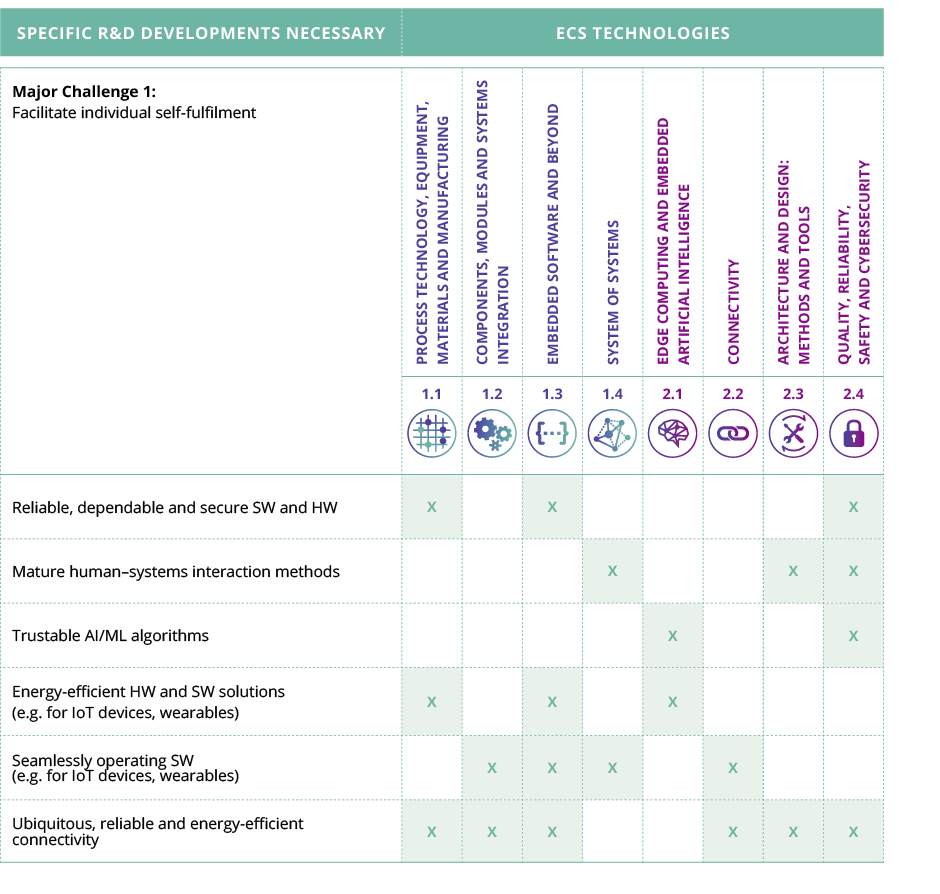
3.6.4.3 Major Challenge 3: Facilitate inclusion and collective safety
Ambition: safeguard collective society and wellbeing for all.
- Societal and digital inclusion.
- Provide societal access for all.
- Ensure collective resilience against setbacks.
Although European countries have different types of welfare models, they also share a history of robust social protection and a focus on inclusive growth, which has been under stress in recent years243. There could be cracks in the sustainability of the EU social contract over the next decade caused by six trends: ageing; digital technology, automation and AI; increased global competition; migration; climate change and pollution; and shifting geopolitics. Based on these trends, inequality may rise again, and divergence within Europe could increase.
Inequality at work may emerge through a combination of: (i) automation and the substitution of labour; and (ii) corporate diffusion dynamics, leading to a competitive disadvantage among non-adopting firms. To prevent reduced employment and secure real wage growth, automation through the use of AI, robotics and other new technologies should lead to significant productivity gains. In general, occupations based on more repetitive and non-digital tasks will be taken by workers with low education and skills, who will therefore be the first to experience pressure on wages.
Collective growth and wellbeing is not only determined by equality at work, but also by individual development supported by collective interactions. Studies have shown that active social relationships increase health and longevity by improving key biomarkers of physical health. A lack of interaction causes a subtle decline in mental health by reducing attention, learning, memory and decision-making skills. In short, our bodies reward us for social interaction and punish us for isolation by negatively impacting mental and physical health. Direct interactions with family and friends, participating in team sports and, for instance, visiting an event with friends are very important. No technology can fully replace direct contact. However, the spread of the Covid-19 virus has shown that direct social interactions may not always be as possible as we have been used to. Thus, we will have to rethink our social interactions, and find out how we can adapt existing and new technologies to increase and improve social interactions – not just between individuals but also between individuals and groups, as well as between different groups. How can improved technologies support existing social interactions, and secure healthy digital social interactions in cases of setbacks?
In addition, collective safety can be enhanced by solutions that directly address specific communities or groups of people the individual is a member of, such as family, friends, neighbourhood, region, (sports)club or association. These solutions can either have a warning or alerting function (e.g. contamination, local fire, local air pollution, incident of violence), but can also be of a supporting nature – for instance, alerts or instructions in combination with collective supporting devices (e.g. automated external defibrillator (AED), diagnostics, measurement).
High-priority R&D&I areas:
- Digital inclusion: tools, infrastructure, training, connectivity.
- Collective safety: secure access control, surveillance, pandemic control, prevention of misinformation without limiting freedom of expression.
- Safe environment for living, working and transport: buildings and bridges resilient against earthquakes through continuous monitoring (e.g. fibre-based stress sensors).
- Emergency/crisis response solutions and services.
- Dynamics of society: systemic change.
As Europe wants to play a major role in digital inclusiveness, it is important to ensure availability and accessibility of solutions to enable remote education, learning, training and assessment of professionals, students and consumers in all regions (both cities and rural areas). Also, solutions to support social inclusiveness for people of all age should become available. ![]()
![]()
The EU has stated, in their document on orientations towards the first strategic plan for implementing Horizon Europe244, that the interaction of science, technology, social sciences and humanities will be crucial in this respect, as will be the input of the creative sector and artists to sustainable inclusive innovation and human- oriented technologies.
To facilitate inclusion, more research will be needed on education, simple human–machine interfaces and digital technology interfaces that avoid the digital split between high- and low-educated citizens. In addition, remote presence and remote connectivity to keep people connected even if they are not in the same location, trustworthy social media, serious gaming, media consumption and AR/VR will be key. ![]()
To safeguard digital inclusion, education is one of the most important research areas. Examples here are the use of AI to build personalised journeys and enhance learning outcomes, to adapt curriculum to individual student needs, digital support and nudging systems to reduce the administrative burden on teachers, tablet-based learning to improve results and decrease distress for students with dyslexia, automation of administrative tasks to free up time and resources for educational professionals, wearable devices that provide real-time support to pupils, eye-tracking solutions to adapt students’ learning experiences, and use of AR/VR to provide immersive experiences to civilians in less well-served areas.
AR may improve connectedness for remote places, reducing the need for commuting or business travel. It could also enable consumers to enjoy an event together even if they are not physically at the event.
There are still several challenges to effectively take full advantage of AI in video creation and consumption. One is the size of video data. Results are only accurate when algorithms are fed with millions of observations. Technologies therefore have to be deployed and strategies have to be implemented to gather data at scale to harness the full power of AI techniques. However, size creates another challenge: datasets need to be manually labelled by humans to train the model, making the process expensive and cumbersome. New techniques that are becoming available to overcome the challenge of (expensive) data categorisation are reinforcement learning, generative adversarial networks, transfer learning and “one- shot learning”. In consumer-facing applications, such as marketing and recommendation algorithms, AI models may need to be refreshed continuously due to changes in the environment that drives them. Continuous updates to AI models are expensive. Other challenges relate to data management and data gathering: to create accurate results with AI, and thus value, different types of data have to be managed in a unified manner. This includes audience data, operational data and content data (metadata). Also, “selection bias” (i.e. the data gathered is not representative of the population studied) has to be prevented to exclude wrong conclusions in a perfectly working model. ![]()
![]()
To facilitate collective safety, further research is required on secure access control, intrusion detection, (video) surveillance of security sensitive areas, and individual and collective activity tracking.
Secure access control as a service (ACaaS) is growing in relevance. This combines biometric readers and identity access management, and can be integrated with other physical security systems (e.g. video surveillance) and building automation systems. Combined with building occupancy management systems, it can deliver valuable information on the location of staff and visitors, and in the event of an emergency to rapidly clear the building.
Covid-19 has brought new physical security requirements. In addition to regular cameras, thermal cameras could be added at the entrance of buildings and venues to measure people’s temperature as they enter premises. Physical access control, enriched with video security evidence, can provide important insights on where an infected individual has been, which doors they have used and who else may have come into contact with those doors and that individual. It can also provide these insights for more general security purposes.
More research on AI security solutions will ease the work of security operators. AI software can analyse images and audio from video surveillance live streams and recordings, and use image recognition algorithms to recognise faces, objects and events, more than a hundred times faster than human operators. AI algorithms can also be used to carry out event detection, scene reconstruction, video tracking, object recognition, and (re)-identification, 3D pose estimation, motion estimation and image restoration. Video surveillance may be extended with freely moving cameras mounted under drones to recognise unusual behaviour in crowds from a high altitude, to monitor hazards such as fires, floods or erupting volcanoes, and to recognise criminal faces and follow targets. Since drones are airborne, they need fast mobile and wireless communications. Low-latency broadband technologies such as 5G can improve the precision and speed of their response times, and enable high-speed communication to a nearby edge computing device. ![]()
![]()
![]()
![]()
![]()
Video quality should be further improved to support deep-learning algorithms, and to improve the video experience in media consumption: the spectral range and colour gamut can be extended, sensitivity has to increase for low light use and dynamic range for better performance under all (and changing) lighting conditions.
AI video and audio algorithms will have to be transparent and explainable. Dedicated video and audio technologies will be required to prevent and trace fake video and audio used to create misinformation in (social) media.
Required R&D&I developments within ECS
To facilitate inclusion and collective safety, specific R&D developments within ECS technology are necessary, as shown in Figure F.93.
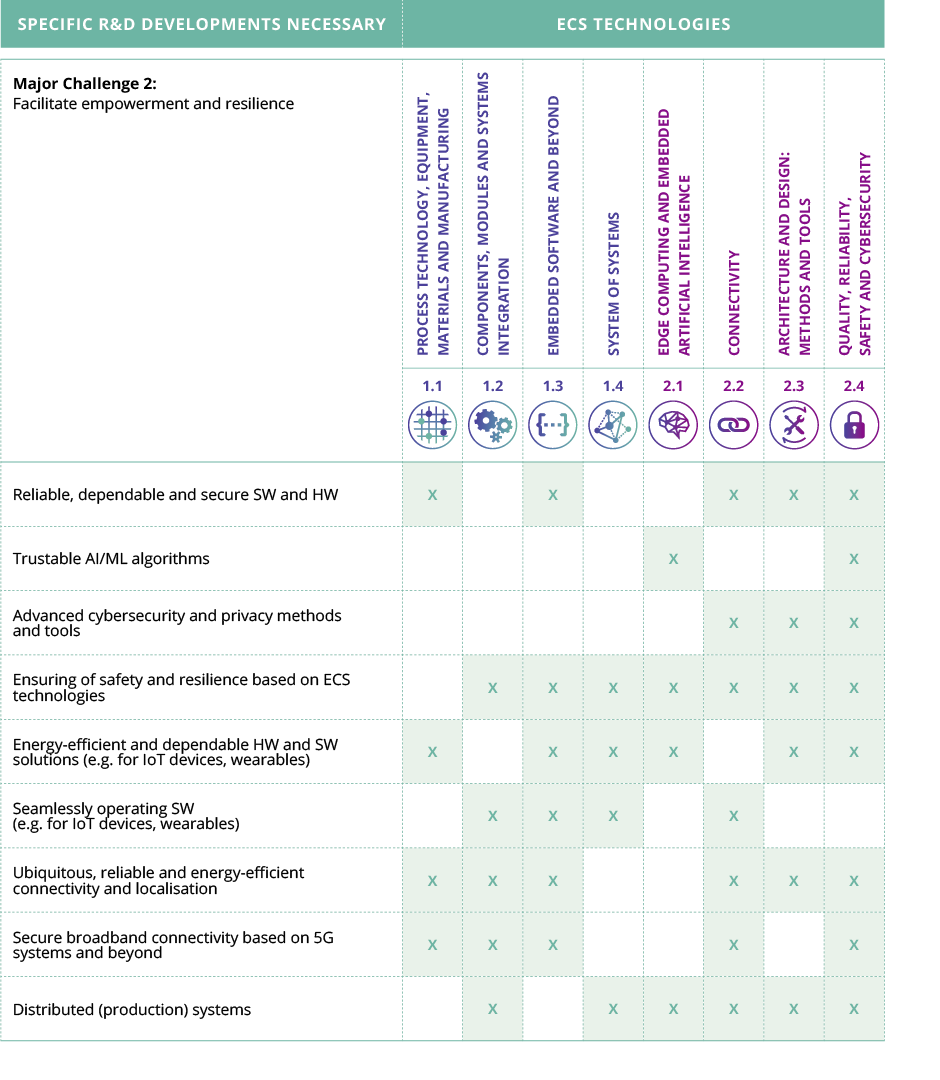
3.6.4.4 Major Challenge 4: Facilitate supportive infrastructure and a sustainable environments
Ambition: contribute to a collective supportive infrastructure and environment.
- Provide reliable and resilient infrastructure.
- Protect society against destabilising forces.
- Establish a sustainable environment.
- Secure controlled climate change.
To fully benefit from the power of digitisation, Europe must enable a supportive infrastructure and environment. Given the rapid pace of change, this requires companies to get their technology, people and culture ready to join the digital transformation. This should be achieved by providing a reliable and resilient digital infrastructure (with ubiquitous and continuous connectivity), protecting society against destabilising forces and establishing a sustainable environment. The former includes preventing harmful use of the internet (e.g. manipulation of elections, misinformation such as “deepfakes” and “cheapfakes”, but also identity theft and phishing), which are covered by Major Challenge 3. The latter includes securing controlled climate change (as stipulated in the Green Deal). Furthermore, monitoring and intelligent control of infrastructures and essential resources (especially in the urban environment) will contribute to a sustainable environment. ![]()
![]()
![]()
The vision is to introduce new digital products and services that contribute to a sustainable lifestyle in all areas of human life, including cradle-to-cradle and circular economy aspects. We are addressing the following aspects:
- Comprehensive assessment of resource usage to identify largest areas of consumption. As well as air quality monitoring systems, they need to offer solutions for lighting, heating, computing with reduced usage of energy, and other resources. In addition, solar panels and batteries, home-grown vegetables and city farming systems are key.
- Providing IoT/smart systems that support the digital business life with the minimum amount of resources (energy, water, paper, travelling, etc.), ensuring a highly efficient, productive and sustainable working environment. Reduction of (food) waste in supermarkets and restaurants, as well as resource recycling.
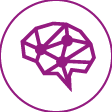
- Smart water management to protect resources. Intelligent management of energy in public spaces such as football stadiums and railway stations, including smart street lighting. Promoting green areas in cities and enabling citizens to provide their own sustainable solutions.
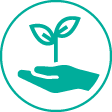
- Sustainability and dealing with climate change.
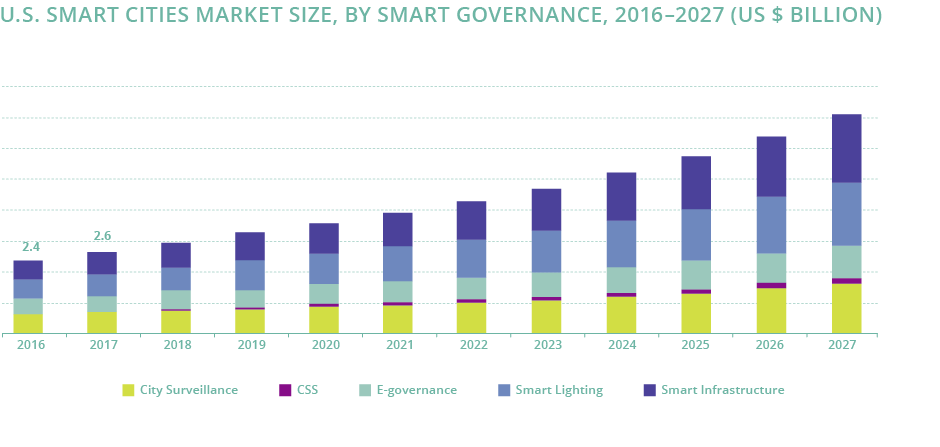
The European approach to working with regard to digitalisation will be focused on the preservation of our democratic system, and on values such as trust and cooperation. Ethical requirements will include fairness, accuracy, confidentiality, transparency, accountability, explainability, trustworthiness and absence of bias. This involves offering AI capability maturity programs to companies that use AI in their designs, to coach them in the best ethical points of view. In this way products will become more resilient, accessible, reliable and trustworthy, and hence ready to take part in the new European digital society.
High-priority R&D&I areas:
- Physical infrastructure management/physical resilience.
- Intelligent infrastructure management (intelligent buildings, city-owned infrastructure, synergies with industry, etc.).
- Digital infrastructure management/digital resilience.
- Smart cities: e-government/citizen support.
- Resource monitoring (air, water, etc.) and feedback to enable more effective management.
To further improve digital infrastructures, investments should be aimed at enhancing infrastructure coverage and quality – for example, with broadband rollout and public Wi-Fi. Also, outcomes have to be influenced through legal frameworks and by setting standards. ![]()
Intelligent buildings will require security, eco-friendship and building management. Security systems such as access control and cybersecurity were covered under Major Challenge 3, but the further development of smart lighting, air quality monitoring and control, and IoT-based real-time monitoring of electric, water and gas meters to increase the energy efficiency of buildings with the help of distributed energy systems will improve the wellbeing of occupants and reduce the carbon footprint of buildings. Smart technology (e.g. sensors placed around radiators, boilers, pumps and other machinery to detect critical levels of noise, vibration or heat) will enable facility managers to save maintenance costs by switching from a reactive to a predictive maintenance model. ![]()
![]()
![]()
Cities are very complex organisms. They combine a variety of means allowing for mobility, city infrastructure providing different types of media (gas, water, energy, etc), and citizen-oriented services that increase their quality of life. It is predicted that by 2050 between 68% and 90% of the global population might live in cities, from small municipalities right up to megacities246. This means that, in the near future, technical means will be required to enable digital solutions for more sustainable development in cities of all size and wealth. Available technologies from tech giants such as IBM, Microsoft, Amazon, Google and Cisco raise concerns from city managers about data privacy policies, and the very high maintenance costs caused by licence fees and the potential for vendor lock-ins247. Available open-source solutions – such as the Red Hat integration platform, which could be used in smart city applications – can also easily be acquired by large companies such as IBM248 to be integrated with their company product portfolio offered commercially. This means that, in such a dynamically changing world, open-source solutions that are widely available, promoted and deployed within EU (such as FiWare249) have to be developed to protect European sovereignty and values. Additionally, due to the rich industrial heritage in many EU countries, opportunities for re-using or integrating available well- developed open-source industry platforms, such as the Eclipse Arrowhead Framework250, have to be thoroughly investigated. This is especially the case since industry sites are often integrated within city areas, and therefore naturally create synergies that can influence each other. These smart city applications create natural synergies with the System of Systems, Mobility and Digital Industry sections. ![]()
![]()
![]()
The impact of technology on environmental sustainability is likely to be highly significant. In retail, where shifting customer habits will be key (for example, for new products such as plant- or insect-based food), IoT sensors and devices will also yield a positive impact – for example, by reducing waste through improved food temperature or expiry date management. In the manufacturing sector, smart building applications related to energy and wastewater management, as well as applications such as carbon capture and biofuel generation on industrial sites, will have a significant impact.
Required R&D&I developments within ECS
Development of supportive infrastructure and a sustainable environment within EU needs the following specific R&D developments within ECS technology:

The following table illustrates the roadmaps for Health and Wellbeing.
|
MAJOR CHALLENGE |
TOPIC |
SHORT TERM (2023–2027) |
MEDIUM TERM (2028–2032) |
LONG TERM (2033 AND BEYOND) |
|
Major Challenge 1: |
Topic 1.1: Improved human– machine interaction solutions |
Intensive research on human–machine interaction solutions |
Improved human–machine interaction solutions in pilot phase |
Improved human–machine interaction solutions in the commercial phase |
|
Topic 1.2: Online education and examination |
Developments of methods and solutions for online education and examination |
Online education and examination used in most EU universities, also for education of adults |
Online education and examination widely used across the EU |
|
|
Topic 1.3: VR/AR training and support |
VR/AR pilots, including remote training, support and work< |
VR/AR training, support, and remote work is mature< |
VR/AR training widely used across the EU |
|
|
Topic 1.4: Support devices (wearables, robots, cobots, chatbots, etc) |
Wearables and chatbots used for commonly used devices |
Support devices (wearables, robots, cobots, chatbots, etc) gain more intelligence and interaction |
Support devices (wearables, robots, cobots, chatbots, etc) used in daily life |
|
|
Topic 1.5: Nudging, gamification (for development or health reasons) |
New nudging, gamification systems developed for education and health |
Nudging, gamification pilots in education and health |
Nudging, gamification (for development or health reasons) is widely used across the EU |
|
|
Major Challenge 2: |
Topic 2.1: Access control/ intrusion detection/surveillance |
Classic surveillance systems |
Smart surveillance with rudimentary intrusion detection< |
Smart surveillance with AI-based intrusion detection |
|
Topic 2.2: Reliable and ubiquitous digital infrastructures |
Increased quality of service (QoS) and available bandwidth with 5G, less time-critical functions moving to the cloud |
|
|
|
|
Topic 2.3: Social media/serious gaming/AR/VR |
AR on social media moves from photos to video >80% on social media in video by 2023; in-game systems that self-adapt to guide human learning |
|
|
|
|
Major Challenge 3: |
Topic 3.1: Digital inclusion: tools, infrastructure, training, connectivity |
Development of technologies (AR/VR, hearables, haptics, etc) for digital inclusion |
Pilot deployments of hybrid systems for collective interactions |
Technologies for immersive collective interactions |
|
Topic 3.2: Resilient society against setbacks |
Emergency/crisis response solutions and services with ubiquitous localisation |
Trustable solutions for collective activity tracking, access control and intrusion detection |
Trustable AI-supported hybrid solutions for resilient society |
|
|
Topic 3.3: Societal acceptance of novel technologies |
Technologies (serious gaming, nudging, etc) for societal acceptance and adaptation |
Human-oriented trustable AI systems and technologies |
Trustable AI for collective growth and wellbeing |
|
|
Major Challenge 4: |
Topic 4.1: Physical infrastructure management/ physical resilience |
Development of IoT and dedicated robot-based inspection systems supported by AI algorithms |
Pilot deployments of trustable AI-based systems relying on dependable edge/cloud IoT |
Intelligent, affordable and trustable IoT and robot-based systems are available |
|
Topic 4.2: Intelligent infrastructure management |
Development of systems for intelligent management of infrastructure (water, street lighting, heat, etc) |
Pilot deployments of trustable AI-based orchestration systems to create synergies in infrastructure management |
Smart systems for multi-domain infrastructure orchestration and management available |
|
|
Topic 4.3: Digital infrastructure management/digital resilience and cybersecurity |
Acceleration of initiatives to create open, secure privacy- oriented systems; development of AI-based algorithms for increased cybersecurity |
Adaptation and pilot deployments of available interoperable open and reliable systems supported by trustable AI algorithms for increased cybersecurity |
Open, secure, interoperable and reliable privacy-oriented systems empowered by trustable AI-based IoT solutions available |
|
|
Topic 4.4: Surveillance, homeland security and emergency response systems |
Edge/cloud solutions, IoT systems and robot-based inspection platforms, increased multimodal situational awareness, ubiquitous localisation< |
Deployment of trustable AI-based edge-cloud solutions, IoT systems and robot-based inspection platforms for surveillance and emergency response support |
Trustable and dependable AI-based IoT systems and robot-based inspection platforms for increased situational awareness widely available |
There is synergy with several other ECS key application areas, which has been delineated as follows:
- Mobility: where the Mobility Chapter mainly addresses infrastructure-related aspects, Digital Society implies “being on the move” from time to time. The aspects addressed by the Major Challenges for Digital Society in general therefore also apply when being on the move.

- Digital Industry: while sustainability is an important aspect of life in the digital society, this is also addressed in the Chapter on Digital Industry.

- Energy: electrical energy is a prerequisite of a digital society, as smart devices are based on it. Although in general energy generation and distribution is a different area, energy scavenging of IoT sensors and actuators, energy storage and wireless charging of smartphones and other wearables can be essential elements of a digital society.

- Health and Wellbeing: where healthcare aims to cure people of diseases, wellbeing implies measures to keep healthy people healthy. The Major Challenge “Ensuring individual empowerment and wellbeing” will contribute to the aim of keeping healthy people healthy by supportive products and services in the Digital Society.

- AgriFood and Natural Resources: the protection of natural resources can be considered part of ensuring environmental sustainability; for the rural, this is addressed in the Chapter on AgriFood and Natural Resources, while the urban lies more in the scope of Digital Society.

There is also synergy with some other ECS technology Chapters:
- Quality, Reliability, Safety and Cybersecurity: there are relevant Major Challenges in that Chapter that link to this Chapter on Digital Society: quality and reliability, ensuring dependability in connected SW, privacy and cybersecurity, safety and resilience, and human–systems integration.

- Connectivity: homeland security and cybersecurity of the digital society needs reliable connectivity infrastructure.
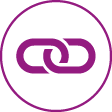
- System of Systems: smart city topics require reliable digital solutions that can handle a variety of many interconnected systems within cities.

235 https://www.forbes.com/sites/louiscolumbus/2018/01/12/10-charts-that-will-change-your-perspective-on-artificial-intelligences-growth/#31791eef4758
236 Gamification: The application of game design elements and principles in a non- game context.
237 https://www.trainingjournal.com/articles/ opinion/how-promote-lifelong-learning- using-technology
238 https://www.mckinsey.com/featured-insights/future-of-work/tech-for-good-using-technology-to-smooth-disruption-and-improve-well-being
239 McKinsey Global Institute: “Tech for Good: Smoothing disruption, improving well- being”, May 2019, p 42 and p 43.
240 McKinsey Global Institute: “Tech for Good: Smoothing disruption, improving well- being”, May 2019, p 58.
241 LioniX, Surfix and Qurin Diagnostics (supported by PhotonDelta).
243 Testing the resilience of Europe’s inclusive growth model, McKinsey Global Institute, December 2018, p4.
244 https://ec.europa.eu/research/pdf/horizon- europe/ec_rtd_orientations-towards-the- strategic-planning.pdf
245 Source: Grand view Research: “Smart Cities Market Size, Share & Trends Analysis” Report by Application (Governance, Environmental Solutions, Utilities, Transportation, Healthcare), By Region, And Segment Forecasts, 2020 – 2027. See https://www.grandviewresearch.com/industry-analysis/smart-cities-market
246 https://www.un.org/development/desa/en/news/population/2018-revision-of-world-urbanization-prospects.html
247 https://www.smartcitiesworld.net/news/news/city-governments-fear-vendor-lock-in-from-iot-platforms-3776
